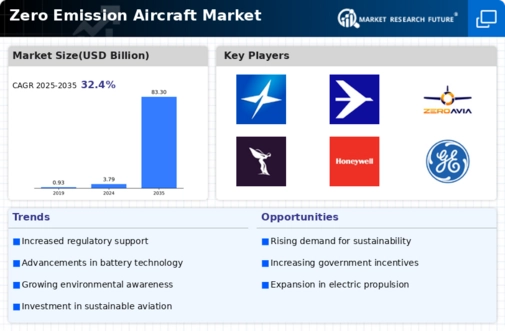Regulatory Support
Government regulations play a crucial role in shaping the Global Zero Emission Aircraft Market Industry. Many countries are implementing stringent emissions targets and offering incentives for the development of zero-emission technologies. For example, the European Union has set ambitious goals to reduce aviation emissions by 55 percent by 2030. Such regulatory frameworks encourage manufacturers to innovate and invest in cleaner technologies, thereby accelerating market growth. The support from regulatory bodies not only fosters a conducive environment for research and development but also enhances public awareness about the environmental impact of aviation, potentially increasing demand for zero-emission aircraft.
Environmental Concerns
Growing environmental concerns significantly influence the Global Zero Emission Aircraft Market Industry. The aviation sector is under increasing scrutiny due to its contribution to greenhouse gas emissions. As climate change becomes a pressing global issue, stakeholders are advocating for sustainable practices in aviation. This shift in consumer preference towards greener alternatives is prompting airlines to explore zero-emission aircraft options. The urgency to mitigate climate change impacts is reflected in the market's projected compound annual growth rate of 32.43% from 2025 to 2035. Consequently, manufacturers are compelled to prioritize the development of aircraft that align with environmental sustainability goals.
Market Growth Projections
The Global Zero Emission Aircraft Market Industry is poised for substantial growth, with projections indicating a remarkable increase from 3.79 USD Billion in 2024 to 83.3 USD Billion by 2035. This growth trajectory reflects the increasing investments in research and development, coupled with the rising demand for sustainable aviation solutions. The market is expected to experience a compound annual growth rate of 32.43% from 2025 to 2035, driven by advancements in technology, regulatory support, and changing consumer preferences. Such projections highlight the industry's potential to revolutionize aviation and contribute to global sustainability efforts.
Technological Advancements
The Global Zero Emission Aircraft Market Industry is propelled by rapid technological advancements in electric and hydrogen propulsion systems. Innovations in battery technology, such as solid-state batteries, enhance energy density and reduce weight, making electric aircraft more viable. Additionally, hydrogen fuel cells are gaining traction, offering longer ranges and faster refueling times. For instance, companies like Airbus and Boeing are investing heavily in research and development to create aircraft that can operate on these clean energy sources. As a result, the market is projected to grow from 3.79 USD Billion in 2024 to an impressive 83.3 USD Billion by 2035, indicating a strong demand for sustainable aviation solutions.
Market Demand from Airlines
The demand from airlines for zero-emission aircraft is a key factor driving the Global Zero Emission Aircraft Market Industry. Airlines are increasingly recognizing the long-term benefits of adopting sustainable practices, including cost savings from reduced fuel consumption and compliance with future regulations. Major airlines are committing to net-zero emissions targets, which necessitates the integration of zero-emission aircraft into their fleets. This trend is expected to create a robust market for manufacturers, as airlines seek to modernize their fleets with environmentally friendly options. The anticipated growth trajectory of the market underscores the airlines' commitment to sustainability and innovation.
Investment in Infrastructure
The expansion of infrastructure dedicated to supporting zero-emission aircraft is a vital driver for the Global Zero Emission Aircraft Market Industry. Airports and ground facilities are increasingly being equipped with charging stations and hydrogen refueling systems to accommodate the needs of electric and hydrogen-powered aircraft. For instance, several airports are collaborating with technology firms to develop the necessary infrastructure for seamless operations of zero-emission aircraft. This investment not only facilitates the adoption of these aircraft but also enhances operational efficiency, thereby attracting more airlines to consider transitioning to sustainable aviation solutions.























